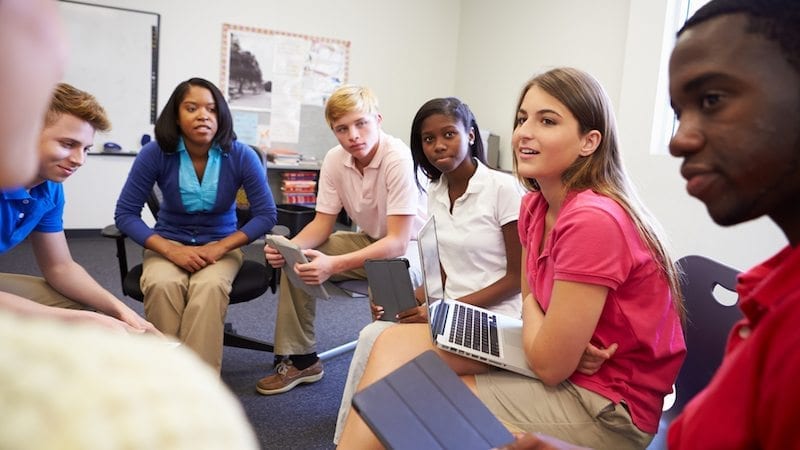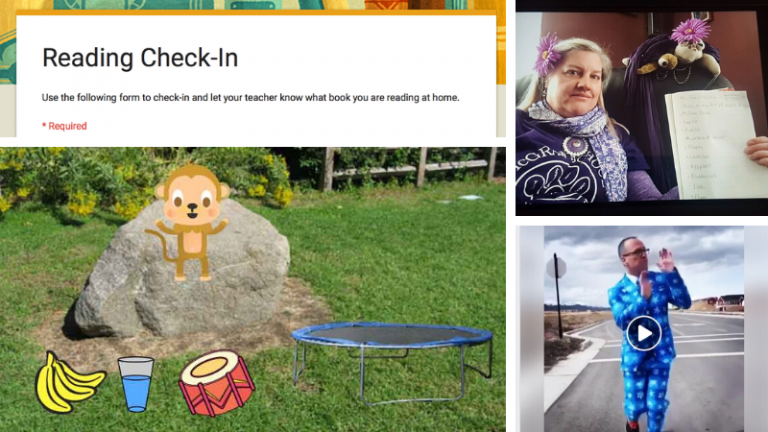These days, the use of technology can change a school culture from okay to wow. We know that school relationships make or break learning. Technology can improve student-teacher relationships, but making it happen requires intention. Here are three ways intentionally integrating technology can more easily improve student-teacher relationships:
1. Integrate curricula and increase engagement through project-based learning (PBL).
“When are we going to use this?” is the rallying cry of all students. It’s a valid point. Helping students apply their learning in real-world ways is known to increase engagement and test scores.
Joshua Giebel, a math teacher at New Tech High School in Columbus, Indiana, does his best to integrate learning authentically. By using PBL, the question of why something matters never even enters students’ minds. Mr. Giebel recently taught geometry by asking kids to solve a furniture problem. The footpads on his classroom chairs broke every time kids leaned back in them. “Using the breakage problem as a focal point for the lesson, we talked about the arcs of circles, arcs on segments, sectors of circles, tangents, and all of the properties that go along with finding the center point of an object. Then, using an AutoCAD program and a 3D printer, students redesigned the chair footpads.”
Mr. Giebel’s students not only learned geometry standards for the quarter, they learned why the standards matter. They also gained experience with some technology tools they could apply to real careers. This was both motivating and engaging for the students.
But Mr. Giebel’s lesson was not without challenges. Managing all the details and standards addressed was an issue. The solution? He and his students are now using a centralized technology platform called itslearning to submit journal assignments, write reflections, and create and store presentations. The kids can still use tools like Prezi and Google Docs, but itslearning allows them store all of their materials in one digital location.
TRY THIS! Host a hack-athon
A hack-athon is a full day when your whole school is asked to solve a single school-centric challenge. The solutions should showcase their process. Hold an all-school assembly to share individual and group processes and the eventual solution.
2. Give students choice and voice while you manage the moving parts.
Recently Dean Wright, a third grade teacher at Columbus Signature Academy in Columbus, Indiana, shared ideas for a social studies project with his students and let them decide what to do. He knew they’d be more motivated if given a choice. The students chose to sell homemade goods at a local farmers’ market, and Mr. Wright figured out how to build in different goals for the project. Mr. Wright used itslearning to help increase student independence without losing control of the moving parts of each lesson. The itslearning platform gave his students tools to work on pieces of the project and share progress digitally.
Mr. Wright’s students couldn’t wait to get in his classroom every day and get to work. That level of learning engagement and community connection contributes to a positive school culture. Using educational technology to promote independence gives teachers and students the tools they need so they can do the teaching and learning.
TRY THIS! Five-point scale self-reflection
Have students use a five-point scale to rate how sure they are about an answer they’ve given. This helps keep kids thinking about what they know, what they think they know, and the difference between the two. The more they think, the more engaged they are.
3. Build growth mindset in every student regardless of proficiency.
As a high school science teacher in Millis Public Schools in Massachusetts, Stephanie Copice spends a lot of time introducing students to content they’ve never seen before. In the past, she used textbooks, classroom lectures, and science labs to achieve this goal. Any students who didn’t understand either had to approach her for extra help or wound up floundering as the rest of the class moved on to the next lesson. Conversely, students who did understand had no avenues for working ahead. Then, Ms. Copice started using the itslearning grade book and advanced reporting tools to track where students were and put enrichment options into place for students to work through independently. The class began to grow—each students’ needs were being met and learning was constantly accessible.
Successful students have the mindset that they can always grow and change. itslearning can help build that mindset by giving students voice and choice over their learning paths, continuous feedback on their effort and stamina, and personalized materials based on their skills and interests.
TRY THIS! The wall of growth
Have the students at your school create a wall of growth. Each grade will be asked to create one poster that symbolizes math or whatever subject you choose. They all get the same directions, but when posted in order by grade, everyone can see how the idea (and knowledge) grows each year.


